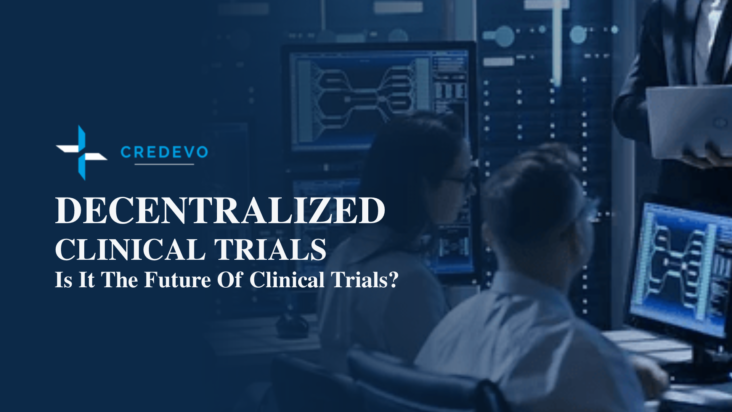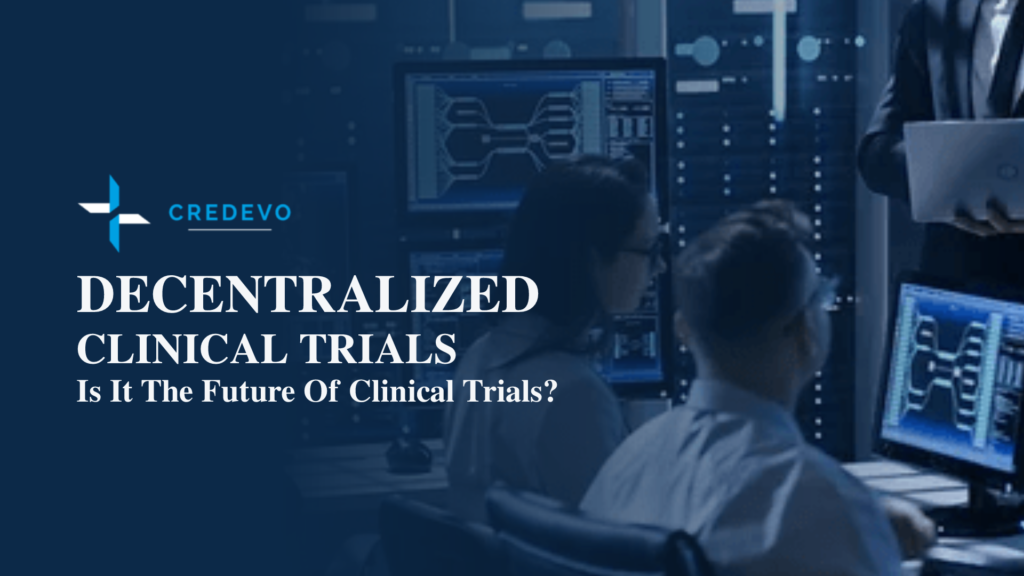Decentralized Clinical Trials: Is It The Future Clinical Trials?

Decentralized clinical trials (DCT)s, also known as “direct-to-participant trials,” “virtual” monitoring, or “remote clinical trials“, differ from conventional research studies. These clinical trials use telemedicine, sensory-based technology, home visits, wearable medical devices, patient-driven virtual health care interfaces, direct drug and material delivery to patients’ homes, neighborhood labs, digital consent data gathering, remote monitoring, and diagnostics in clinical trials as “virtual” approaches.

Decentralized clinical trials have innovative technologies and participant-centered design in combination. We can run a decentralized clinical trial remotely or employ a hybrid approach that still needs some physical site attendance.
In a fully decentralized clinical trial, participant enrollment, medicine delivery and administration, and data collection on trial outcomes proceed without direct interaction with the study staff and the patient. DCTs frequently incorporate traditional design with decentralized patient/subject interactions and clinical trials for medication approval.
These studies reduce or eradicate the requirement for in-person interactions between researchers and participants. Researchers have various opportunities to use this trial strategy due to the epidemic and significant historical technological advancements.
How to plan a decentralized clinical trial?
- Evaluation of the risk
- A thorough risk analysis forms the foundation for a decentralized clinical trial. It is essential to have a Risk-Based Quality Management (RBQM) process that enables you to identify risks early on, monitor them, and offer insights.
- We will use a thorough RBQM process to identify the type of decentralized solution needed for your clinical trial.
- Patient Emphasis and Study Logistics
- Any decentralized solution must have the patient as its primary focus, including taking participation, safety, and logistical issues into account.
- Remote consenting
- To create remote informed consent procedures that abide by the legal standards, we have conferred with IRBs. A decentralized clinical trial cannot start until this procedure is established. If your study began before the pandemic, you might need to update and re-consent subjects in light of any necessary adjustments made to the trial design regarding subject visits and perhaps even for the prospective remote review of subject data.
- Remote Recruitment and Enrolment Procedures
- During the feasibility and qualification phases, discussions about the digital management of enrollment and recruitment with the clinical sites are necessary. To ensure that sites are ready to begin recruitment and enrollment operations as soon as they are available, ongoing discussions with clinical sites and any vendors (if used) should happen throughout the site activation period.
- Telemedicine visits
- Telemedicine visits have several facilities to assess the subject’s safety throughout a decentralized study. Telehealth, which employs computer and mobile technology for digital information and communication, allows patients to receive medical services remotely. The clinical site staff communicates with the patient during a telemedicine visit via phone or web conference to discuss changes to the patient’s medication schedule.
- Health Care at Home
- A typical home health care program that we have put in place links patients with a certified medical practitioner for in-person assessments. The patient chooses a convenient time and place for the appointment, and the home health care professional does safety checks like blood collection and vital sign review and evaluation during the visit.
- Lab Draws
- For some blood collections, it’s crucial to consider using a local laboratory as an option. We can decrease the patient’s burden by allowing blood draws to be performed at a lab closer to the patient’s house. Additionally, we can team up with a supplier who helps patients collect blood, urine, saliva, and stool samples at home and send them straight to the lab for examination.
- Shipments of investigational products (IP) made directly to patients (DTP)
- There are methods for distributing IP, such as home delivery or courier services, to send IP directly to patients’ homes. To ensure that IP maintains a specific temperature while in transit, shipping partners use a controlled temperature shipper and temperature monitoring equipment.
- Off-Site Monitoring
- Several off-site monitoring techniques are available to meet the needs of specific decentralized clinical studies.
- individualized risk-based monitoring strategies and levels
- off-site monitoring
- targeted site data verification (TSDV)
- We can choose the best combination of these solutions depending on the risks found during the RBQM process, the current state of your clinical trial or program, and the level of access to your clinical sites.
- Several off-site monitoring techniques are available to meet the needs of specific decentralized clinical studies.
- Visualization of Data and Centralized Monitoring
- Any decentralized system must include remote clinical data review. The clinical data, including information relevant to site management operations and data relating to safety issues, are monitored centrally to spot trends. With the aid of centralized monitoring systems, we can quickly identify important quality and risk indicators, track them throughout the study, and give timely information to assist you in a decentralized clinical trial.
- Update Study Protocols/Plans –
- Make sure to update research plans and procedures throughout your trial or program to record prospective adjustments to your decentralized strategy. Updating protocols will assure compliance and produce accurate data that supports endpoints.
Deploying digital technology in decentralized trials
The digital technology used in decentralized clinical trials plays a crucial role. The FDA refers to the devices as “digital health technologies,” or DHTs.
- DHTs are any devices used to gather data from trial participants remotely, continuously, or periodically.
- Digital health technologies are often sensor-based systems that capture behavioral or physiological data.
- DHTs may also be software-based programs that keep electronic records of patient-reported outcomes, performance outcomes, and clinical outcome assessments (COAs) (PROs).
- When we gather data electronically, we refer to COAs, PROs, and PerfOs as eCOAs, ePROs, and ePerfOs.
Importantly, not every DHT is FDA-approved or cleared for a specific use. Instead, we use some digital tools as part of a clinical trial. According to the FDA, DHTs used in clinical research would not need to get permission or clearance.
The most important considerations are the use of
- DHTs in trials
- the environment in which we use them.
- If the tool can gather evidence in that situation
The Medical Device Development Tool (MDDT) Qualification Program, which the FDA administers to determine whether a DHT would generally be eligible for use in clinical development programs, has long been interested in this subject. We can reduce the risk associated with the development process by using an FDA-approved digital tool.
Information about digital health technologies.
After recruiting the participants for the clinical trial, we must gather data as part of the procedure. Digital data in clinical trials is
- Electronic medical record data
- Biological samples
- Demographics and medical information
- Patient-reported outcomes and images via a smartphone or tablet.
Digital biomarkers
Measurements of physiologic, pathologic, anatomical, behavioral, social, or activity traits can be objectively collected and “assessed as an indicator of normal biologic processes.
Safety surveillance
Researchers may be able to identify unusual events or ones that are situation-specific and unlikely to happen during a study visit by using digital technology to gather data in real time.
The speed at which we identify and report adverse and safety events significantly impact the promptness with which we conduct clinical trials.
Data protection (privacy and security)
We should consider privacy, safety, and regulations when using digital health technologies. As a result of digital technologies and remote monitoring, security methods to avoid data breaches during data management is mandatory.
Top advantages of decentralized clinical trials
- Decentralized clinical trials can make research more accessible to people from a more expansive demographic who might not otherwise participate in site-based clinical trials.
- Improvements in participant recruitment and increased involvement and diversity
- The ease of participation in decentralized clinical trials, which allows for flexibility, requires fewer in-person study visits, permits passive data collection, and removes barriers to participation like geographic factors, time constraints, and travel, has been identified as the main benefit by researchers.
- Trial outcomes are more generalizable because decentralized studies allow for more diverse and representative cohorts.
- Decentralized clinical trials allow for the study of uncommon diseases with geographically distributed participants, which advances our understanding of these conditions and has the potential to enhance overall healthcare.
- They support the delivery of remote healthcare, help generate relevant individual patient data, quickly address clinical queries or concerns, enable ongoing monitoring of adverse effects, and finally aid in improving knowledge of the patient experience.
The FDA’s recommendations for decentralized clinical trials
- “Fit-for-purpose” describes the DHT as having adequate properties to facilitate its use and interpretability in clinical inquiry. Sponsors must keep this consideration in their minds.
- The draft guidance emphasizes that sponsors must consider several factors when evaluating the justification for using it in a clinical trial.
- The DHT’s secrecy is yet another necessary factor.
- We should continue to collect data consistently.
- Consider the DHT’s usability in addition to its accuracy.
- Verify all endpoints
- Informed consent: The FDA has already provided instructions on the electronic collection of informed consent signatures. Although the guidance doesn’t go into great detail on the subject, the FDA does point out that some tools require
Conclusion
- Clinical trial decentralization is a growing field of research with a lot of potentials. It can take advantage of technological advancements to improve efficacy, participant experience, and generalizability of clinical studies.
- Decentralized clinical trials have several drawbacks in patient safety, staff workload, and patient burden, notwithstanding their benefits.
- Clinical trial researchers must publish the advantages for participants, staff, and research data. Such knowledge will enable future decision-making regarding centralized clinical trial applications.
Do You Need More Information About How Decentralized Trials Benefits Your Clinical Trials? Or Need Any Other Support For Your Clinical Trial?
Credevo provides complete end-to-end support in clinical trial solutions for your clinical trial. Provide your details below to connect with us.